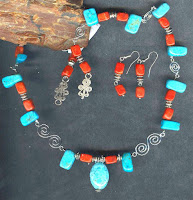
Wild Horse Magnesite and Sleeping Beauty Turquoise Pendant and Necklace
Several e-mails have been received asking if it is possibel to visit and/or go 'rock-hounding' at the various Turquoise Mines while visiting Tucson, or while driving to or from Tucson through Nevada, Utah or New Mexico. After considerable research, one of the best answers I found pertaining to the formation, finding and mining of Turquoise comes from Dillon Hartman of Indian Village Mines, Durango, COLORADO. The following comes from Dillon's IndianMines.com web-site.
"Turquoise depends on the whims of nature for its formation. It is not a material that originated deep within the earth as a primary mineral. Rather it relies on weathering and the ingredients of the earth’s crust for its formation.
.
Turquoise is found in or near copper deposits as it depends on the presence of copper ions for its formation. Turquoise is a hydrous hydrate of copper, aluminum, and phosphorus. The latter element is combined with oxygen and called the phosphate radical. Radicals act as single chemical units, though they may be made up of two or more elements.
.
There was a time when turquoise could be collected by rock hounds. Small deposits were accessible but now it is nearly impossible to go into the field and find and dig turquoise. Turquoise deposits were known to the Native Americans of the Southwest long before copper mining was a fact. In Arizona, for example, a very active trade developed between the coastal tribes who gathered shells and the interior tribes who dug turquoise in several places as well as salt from the Camp Verde region of central Arizona.
.
When the Spaniards came to the New World, turquoise was seen as a common component of ceremonial and royal robes and jewelry. With their lust for gold, the Spaniards paid little attention to this gemstone. This is certainly not true today, as turquoise has taken its place on the list of highly regarded gems.
.
When copper mining came to the New World, turquoise became more available. Since turquoise has no ore value of consequence, it occurs in minor amounts in copper deposits. It was possible for miners to easily gather small fragments of turquoise rock and take them home without hassle.
.
If you want to collect turquoise today, the only option is to go to an operating mine where permission is a must. Rarely is it possible for the individual collector to obtain good rough on his or her own. The vast amount of turquoise being mined is obtained under contract with one of the big copper companies operating an open pit."
.
Without trying here to identify places to go to find Turquoise in the United States, or elsewhere in the world, recommend you visit the
http://www.indianmines.com/ site and find the state or country listed that you want to know about Turquoise in that area. There is a great History lesson about Turquoise on the same site. There are plenty of pictures to also help you recognise the various turquoise from the different mines.
.


































.jpg)


























